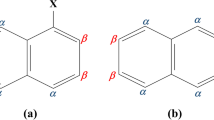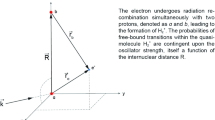Abstract
The microwave spectrum of 1,3‐dioxolane (C3H6O2) in the ground and first three excited states of hindered pseudorotation was studied. The transitions corresponding to the μb, μc, and μa components of the dipole moment were identified. The spectrum was analyzed using numerical diagonalization of the effective rotational Hamiltonian for four interacting states of hindered pseudorotation. The rotational constants, centrifugal distortion constants, the constants of interaction between general rotation and hindered pseudorotation, and the distances between the quasidegenerate vibrational levels Δ01 = 64840.5, Δ12 = 122231.7 and Δ23 = 119732.7 MHz are determined. From the Stark effect of microwave transitions, the dipole moment components (in Debye units) in the hindered‐pseudorotation states v = 0, 1, 2, and 3 are determined: 〈0|μb|0〉 = 〈1|μb|1〉 = 1.22, 〈2|μb|2〉 = 1.20, 〈3|μb|3〉 = 1.21, 〈0|μc|1〉 = 0.77, 〈2|μc3〉 = 0.66, and 〈1|μa|2〉 = 0.19.
Similar content being viewed by others
REFERENCES
J. E. Kilpatrick, K. S. Pitzer, and R. Spitzer, J. Amer. Chem. Soc., 69, 2483 (1947).
D. O. Harris, G. G. Engerholm, C. A. Tolman, et al., J. Chem. Phys., 50, No. 6, 2438-2445 (1969).
G. G. Engerholm, A. C. Luntz, W. D. Gwinn, and D. O. Harris, ibid., pp. 2446-2457.
J. A. Greenhouse and H. L. Strauss, J. Chem. Phys., 50, 124-134 (1969).
W. N. Sont and H. Wieser, J. Raman Spectroscop., 11, No. 6, 334-338 (1981).
R. Davidson, J. Hog, J. A. B. Whiteside, and P. A. Warsop, J. Chem. Soc. Faraday Trans., 68, 1652 (1972).
P. A. Baron and D. O. Harris, J. Mol. Spectroscop., 49, No. 1, 70-81 (1974).
J. R. Durig and D. W. Wertz, J. Chem. Phys., 49, 675 (1968).
A. Kh. Mamleev, L. N. Gunderova, and R. V. Galeev, “Microwave spectrum of the tetrahydrofuran molecule in the excited states of hindered pseudorotation,” Deposited at VINITI, No. 3679-B99 (1999).
A. Kh. Mamleev, L. N. Gunderova, and R. V. Galeev, Zh. Strukt. Khim., 42, No. 3, 439-445 (2001).
A. Kh. Mamleev, L. N. Gunderova, R. V. Galeev, and A. A. Shapkin, Issled. Rossii (Electron Journal), 93, 1029-1037 (2001). (http://zhurnal.ape.relarn.ru/articles/2001/093.pdf.)
J. K. G. Watson, J. Chem. Phys., 46, 1935 (1967).
J. S. Muenter, J. Chem. Phys., 48, 4544 (1968).
S. Golden and E. B. Wilson (Jr.), J. Chem. Phys., 16, 669-685 (1948).
J. E. Wollrab, Rotational Spectra and Molecular Structure, Academic Press, New York-London (1967).
Author information
Authors and Affiliations
Rights and permissions
About this article
Cite this article
Mamleev, A.K., Gunderova, L.N., Galeev, R.V. et al. Microwave Spectrum and Dipole Moment of 1,3‐dioxolane in the Hindered‐Pseudorotation States v = 0, 1, 2, and 3. Journal of Structural Chemistry 43, 757–760 (2002). https://doi.org/10.1023/A:1022812921496
Issue Date:
DOI: https://doi.org/10.1023/A:1022812921496




